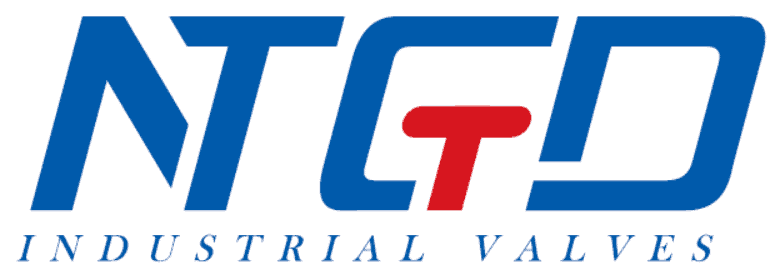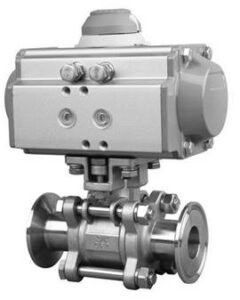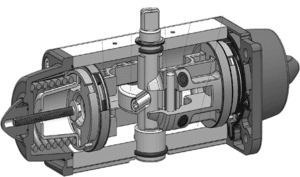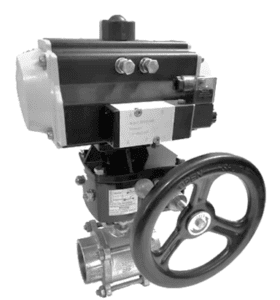Pneumatic Ball Valve
Pneumatic Ball Valve
※ Size Range: 2″-36″
※ Class Range: 150LB-2500LB
※ Fire Safe Design
※ Anti Static
※ Anti blow-out
※ Pneumatic Ball Valve Manufacturer
Introduction
Ball valves are frequently referred to as pneumatic ball valves when a pneumatic actuator is used to automate and remotely control the operations. In addition to reducing the need for labour and material resources, automating manual operations also allows for the control of several ball valves. Automation with a pneumatic actuator could be more beneficial based on the application. In this article, we will have a deeper insight into Pneumatic Ball Valve. But first, let me give you a quick overview of a ball valve and an actuator before going into more depth about a pneumatic ball valve.
- Ball Valve: A ball valve is a quarter-turn valve with a hollow spinning ball inside that regulates the flow of a medium. The valve opens and the media may flow through once the hollow section of the ball is aligned with the flow (pipe or hose). With a 90-degree rotation of the ball (thus the term quarter-turn valve), the valve closes when the solid section of the ball is parallel to the flow.
More precisely controlling the flow is achievable if you put the valve somewhere between fully open and entirely closed. A typical ball valve has two ports: an intake port and an exit port. However, three ports (L or T) are also offered by pneumatic ball valve manufacturers; how these ports are used will depend on how the valve is put together and fitted as well as how the ball’s 90-degree rotation affects the direction of media flow. Ball valves with four ports are feasible but uncommon.
A valve stem, which is connected to the ball and regulates its rotation, is present in ball valves. To operate the valve, a manual handle is attached to the valve stem. The ball valve can be opened and/or closed mechanically and/or remotely by spinning the stem of the valve, which can also be coupled to a pneumatic rotary actuator.
- Actuator: An instrument called a valve actuator is employed to remotely operate a valve. The actuator is called a quarter-turn actuator if it is designed to control a quarter-turn valve. If you want to operate the valve automatically and/or remotely, you may attach an actuator on it in place of a manual handle. The force needed to operate (rotate) a ball valve is produced by actuators using a power source. The power source for the majority of actuators is either pneumatic, electric, or hydraulic. This power source’s differences lead to several designs, each of which has unique benefits and drawbacks for certain applications. An actuator may have additional features such as position indications and manual override in addition to the torque-generating component.
What is Pneumatic Ball Valve?
The pneumatic actuated ball valve, which automates the operation and saves a significant amount of labour and material resources, is mainly composed of a pneumatic operator and a ball valve. It also has the ability to operate multiple ball valves. Operation of pneumatic actuators occurs rather quickly, with the highest switching speed being 0.05 seconds per turn. Pneumatic Ball Valves include two types of actuators: single-acting and double-acting. They also have accessories like positioners, limit switches, and other parts that may be used to regulate flow throttling. The switch in the remote-control room can be controlled simultaneously with the control box.
Pressurized air or gas is the main power source for pneumatic ball valves. These actuators don’t use motors, although they do need electric power when used with an inbuilt solenoid valve, also known as a pilot valve. The ball valve opens and closes when the solenoid (pilot) valve gets an electronic signal that energizes its coil and causes air to flow into or out of the pneumatic actuator. The air source drives the ball core to rotate between 0 and 90 degrees, and a very small amount of force can handle the ball valve rotation. The valve positioner can be set up in accordance with the working situations to regulate the ball valve’s opening, which changes the flow of the medium.

Types: Pneumatic Ball Valve.
There are two different kinds of pneumatic actuators: double-acting and spring-return. Both use a rack and pinion mechanism, which is renowned for its dependability and toughness.
- Double-Acting Type: Double-acting actuators spin the actuator pinion 90 degrees by using air to drive internal pistons (racks) in both directions. The pinion, which is attached to the ball valve stem, spins to open or close the ball valve. When power is removed, double-acting actuators will revert to their default position and can be set to operate normally open or usually closed. Double-acting actuators will maintain their present position if the air supply is cut off.
- Spring Return Type: In a spring-assisted system, inner pistons are moved by air in one direction and by springs in the opposite direction. These actuators can also be provided with an air-to-close, spring-to-open function in addition to their typical air-to-open, spring-to-close action. Double-acting is a preferable option for high-cycle applications since mechanical springs might be prone to fatigue. In the case of a power outage or a reduction in air supply, spring-return actuators will come back to their initial position.
Working Principle: Pneumatic Ball Valve.
Rack and pinion actuators are the most popular type of pneumatic actuator used with ball valves. This consists of a circular gear called the pinion and a linear gear called the rack. To provide linear motion, the rack is connected to a piston that is propelled by compressed air. The pinion transforms this linear motion into circular motion. In order to open and close, a ball valve’s stem is moved by the pinion.
Solenoid valves manage the pressurized air to operate the pneumatic operator for ball valves. The controller sends electrical instructions to the solenoid valve, prompting it to open or close, enabling pressurized air to pass through from both piston sides of the pneumatic actuator. The ball valve’s stem is attached to the pinion, which is turned by the pinion being pushed by the piston.
Application: Pneumatic Ball Valve.
Pneumatic actuated ball valves are commonly employed in industries with automatic control systems such as the ones utilized in petrochemical, pharmaceutical, light industry, healthcare, and paper and pulp. The primary function of a pneumatic ball valve is to stop or start the flow of medium in a piping system. It may also be used to regulate and control fluids. In comparison to many other valve designs, pneumatic ball valves have output torque with an angular stoke, their opening is rapid, stable, and efficient, and are broadly applicable, among other benefits.
Generally, A manufacturing environment is damp and abrasive where compressed air is easily accessible. Due to their high torque, durability, and cheaper material cost, pneumatic actuators are frequently used in installations with a large number of big ball and/or butterfly valves.
Even in the absence of power, the system requires cooling water to cool down any hot water that remains in a heat exchanger and prevent it from overheating. A pneumatic ball valve is ideal in this scenario.
Advantages: Pneumatic Ball Valve.
Pneumatic ball valves are usually made up of a double-acting (single-acting) pneumatic plunger operator and a floating-type ball valve. We may pick pneumatic actuated ball valves more wisely if we are aware of their benefits. High-pressure pneumatically actuated ball valves have the advantages of being tiny, dependable, and easy to maintain. They also have a compact construction. Let’s go over a few additional benefits of pneumatic ball valves in greater depth.
- There is minimal fluid resistance; of all valve types, the pneumatic ball valve has the least fluid resistance.
- The valve stem’s friction moment is decreased by the thrust bearing, allowing the stem to work freely and flexibly for an extended period of time.
- The valve seat of a pneumatic ball valve performs well when it comes to sealing. The pneumatic ball valve’s sealing ability rises with increasing media pressure, and the sealing ring manufactured from PTFE and other elastic materials are simple to seal.
- The packing seal of the valve stem is difficult to break since it is only employed to simulate rotation, and the sealing capability rises as the medium’s pressure rises.
- The pneumatic ball valve has a long service life because materials like PTFE have high self-lubricating qualities and fewer frictional losses with the ball.
- The valve stem is prevented from spraying out by being positioned at the bottom and having a curved step. In order to guarantee the valve stem seal in the event that the fire damages it.
- Spring should be placed between the ball, valve stem, and valve body to help export any static energy that may be produced.
Selection: Pneumatic Ball Valve.
- The ball valve’s connecting mechanism should be taken into consideration first. The usual approaches are welding, butting, and flange. The second is to examine the valve’s sealing mechanism. Generally speaking, there are two types of sealing systems for pneumatically actuated ball valves: hard and soft. Hard describes a sealing mechanism composed of metal. Hard seals offer strong wear resistance and may be utilized in hot situations. The polymer substance used in the soft seal has a comparatively superior seal. There are ball valves for use at normal, medium, high, low, and extremely low temperatures, depending on the operating temperature. It may be classified into low pressure, high pressure, and vacuum based on the working pressure.
- Both single-acting and dual-acting pistons are often utilized. The final step is to choose some additional mounting that goes with the ball valve. These add-ons might be valve positioners, travel switches, or solenoid valves. Ball valves can be utilized with a wide range of other components.
One should take into account the need for explosion prevention while selecting a solenoid valve. The traveling switch is a type of device that may transform an actuator’s rotation into electric signals and transmit them to an instrument to provide feedback on the switch state of a ball valve that is pneumatically operated. Explosion-proof requirements must also be taken into account when selecting switches, which might be mechanical or inductive.
Comparison: Pneumatic & Electric Ball Valves.
- Electric Power Requirements: An electric-powered ball valve uses less energy than ball valves that are pneumatically operated. The complete air compressor mechanism (compression, filtration, lubricators, power, etc.) in pneumatic actuators is responsible for their high utilization of energy.
- Cycling Speed: The rate at which a ball valve that has been opened completely rotates is known as its rotation speed (90 degrees). The rotational speeds of an electric ball valve are often slower compared to a pneumatic ball valve when using the same-sized devices.
- Life Expectancy: Equipment has a life cycle during which it is completely operational and functioning. Since pneumatically actuated ball valves have fewer elements and require less upkeep, they last longer than their electric equivalents. Many parts of electric actuators, including the electric coil, electronic driver, mechanical actuator, etc., require maintenance.
- Cost: A pneumatic ball valve often costs less than an electric one since the construction of the actuators is simpler. Electric actuation is typically preferred when there is no nearby pneumatic system. In the long term, operating a pneumatic valve is more costly since producing compressed air results in increased energy consumption and energy losses.
Summary: Pneumatic Ball Valve.
The pneumatic actuated ball valve itself offers small overall size, dependable sealing, a simplistic design, and ease of maintenance. It is difficult for the medium to damage the sealing surfaces and spherical surfaces since they are frequently in a closed state. Operating and maintaining it is very simple. It is appropriate for use with common working media including water, solvents, acids, and natural gas. It is widely employed in many industries and suited for media with difficult working circumstances, such as oxygen, hydrogen peroxide, methane, and ethylene.
The ball valve’s primary functions include distributing the medium in the pipeline and altering the flow direction. It can be tightly closed with a little torque with simply a 90-degree rotation. Although on-off and shut-off valves are the most common uses for ball valves, more recent innovations have led to the creation of flow throttling and control valves, such as V-shaped ball valves.
You can get in touch with us if you want more information about our products. Our professionals will assist you in making the best choice of product for your requirements.



